Robin Steenman is a mother of three. She is the local leader of the Moms for Liberty chapter in Williamson County, Tennessee. Her motto, repeated at every meeting of the group, is “Have courage. Stand firm. Do all things in love.”
She leads public lectures and peaceful protests against the K-5 curriculum in Williamson County public schools.
She stands to be classified as a domestic terrorist and shaken down by the FBI.
The threat to her and to any other parent whose behavior or speech can be loosely characterized as "efforts to intimidate individuals based on their views" is a result of collusion among officials in the White House and the Department of Justice.
When I interviewed her last week, she gave me access to the material in that curriculum. It is expansive and available online. Her presentations about it are measured, understated, and factual, and when she draws out its implications in the context of K-5 education, her inferences are tightly linked to graphic imagery and quotations from the textbooks.
I use stronger language about this curriculum, which is titled Wit and Wisdom.
It is neither witty nor wise. One word for it is cunning. It pits adult sophistication against the susceptibilities and limitations of children. It has been created by people well-trained in effective teaching methods and in an assumption among educationists most often labeled Constructivism, the idea, when coupled with Marxist assumptions, that all values are merely imagined and sustained by powerful social groups. Believed en masse, such values or beliefs become "truth."
This theory is deeply cynical. Since all values are merely imagined, as these postmodern theorists really believe, then no values are real. If they are socially constructed, as the academic jargon goes, they can be socially destroyed.
Others, freshly imagined, and widely affirmed and reinforced by educators, can offer a different world of values and beliefs, in this case, a darker world. But not without following a passage through nothingness and denial of everything that others might hold universally good and true.
In Critical Race Theory, one head of a many-headed ideological monster, the only pivot of value from right to wrong is skin color. Human color is not a substantial basis for an entire public, personal, morality, or legal theory. For postmodernists, it doesn't signify anything--except that it can be cynically used to advance race consciousness as a destructive force.
That process of destruction and re-creation is what this curriculum is about.
No, it is more: destroying wholesome beliefs and values, then depositing in their place nihilistic and racist ideas.
What better place for this than the minds of children?
The curriculum in Williamson County assumes this postmodern theory, and it deploys effective pedagogical methods to instill suspicion and hatred, shame and fear. Mrs. Steenman is right to lead protests against it. Such protests are good and honorable because they represent her refusal to be complicit in nihilism and evil.
One could start with suicidal ideation in a book titled Brave Irene.

When Irene gets buried over her head in a snowdrift, the storybook text says, “Even if she could call for help no one would hear her. Her body shook. Her teeth chattered. Why not freeze to death, she thought, and let all these troubles end. Why not? She was already buried.”
This is a 1st-grade text. The teacher’s manual asks students to act out the scene. Teachers who follow the manual thus internalize in children a wish for death. The lesson on bravery notwithstanding, the idea of suicide by giving up gets emphasis and repetition.
Another potential suicide appears in the 3rd grade and yet another in fourth grade. In the 3rd grade text, titled Amos and Boris, a mouse "began to wonder what it would be like to drown. Would it take very long? Would it feel just awful? Would his soul go to heaven? Would there be other mice there?”
In the 4th grade selection, a small child sees his mother's infidelity. She is kissing a man who is not his father. It devastates him:

“He wanted to die. . . . He had gone up on the ridge and taken the hatchet and tried to end it by cutting himself.”
“Madness. A hissing madness that took his brain. There had been nothing for him then and he tried to become nothing but the cutting had been hard to do, impossible to do, and he had at last fallen to his side, wishing for death, wishing for an end, and slept only didn’t sleep.”
There are texts on stillbirth (pp. 100-105 in "material"); on brutality in the Revolutionary War (pp. 90-91); and, on cannablism in the wars among and with American Indians (pp. 108-109).
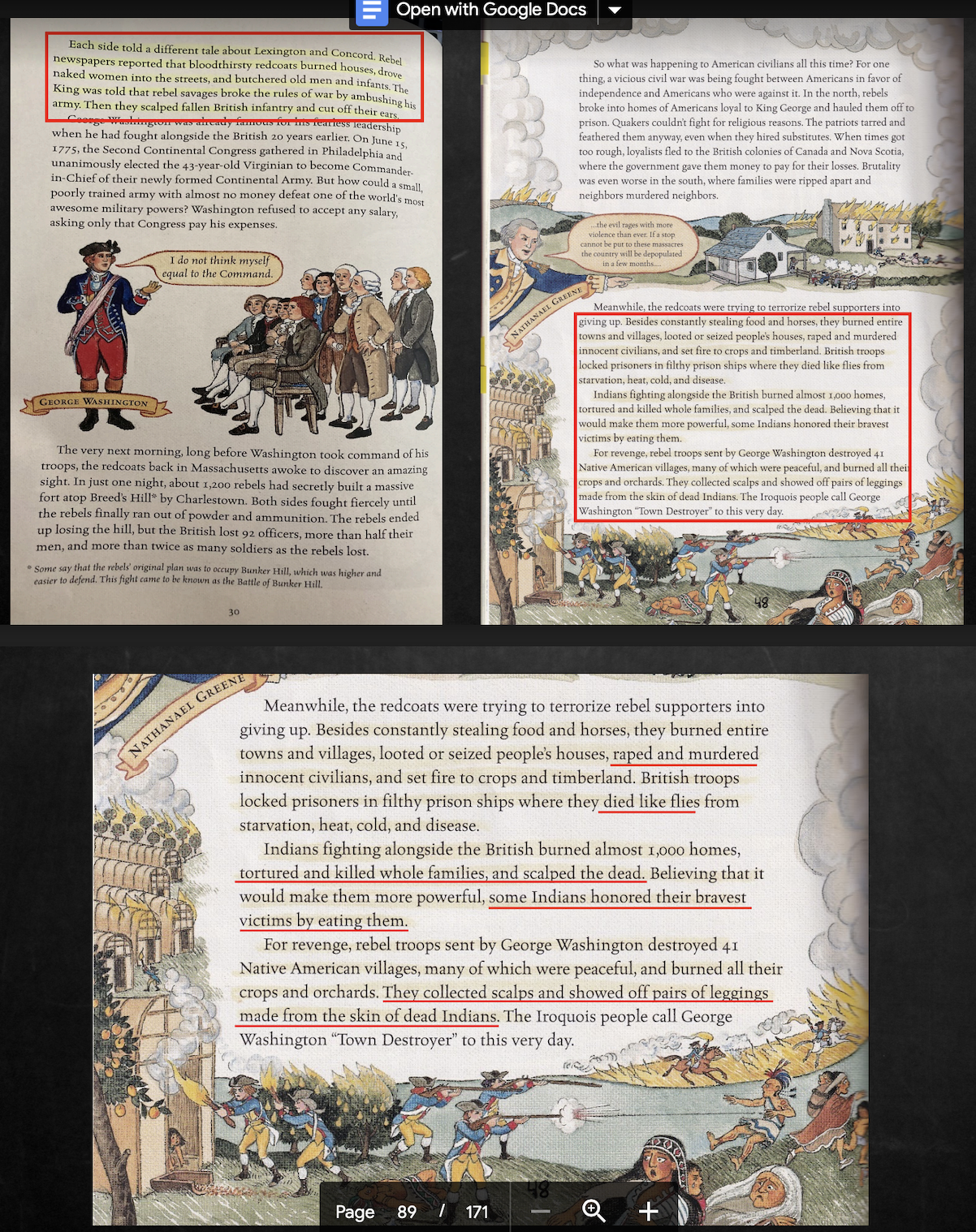
And there is a story of an owlet eaten by a monkey. The owlet’s mother decides not to let the sun rise. For her, it is the end of the world. Cute nihilism, packaged for children.
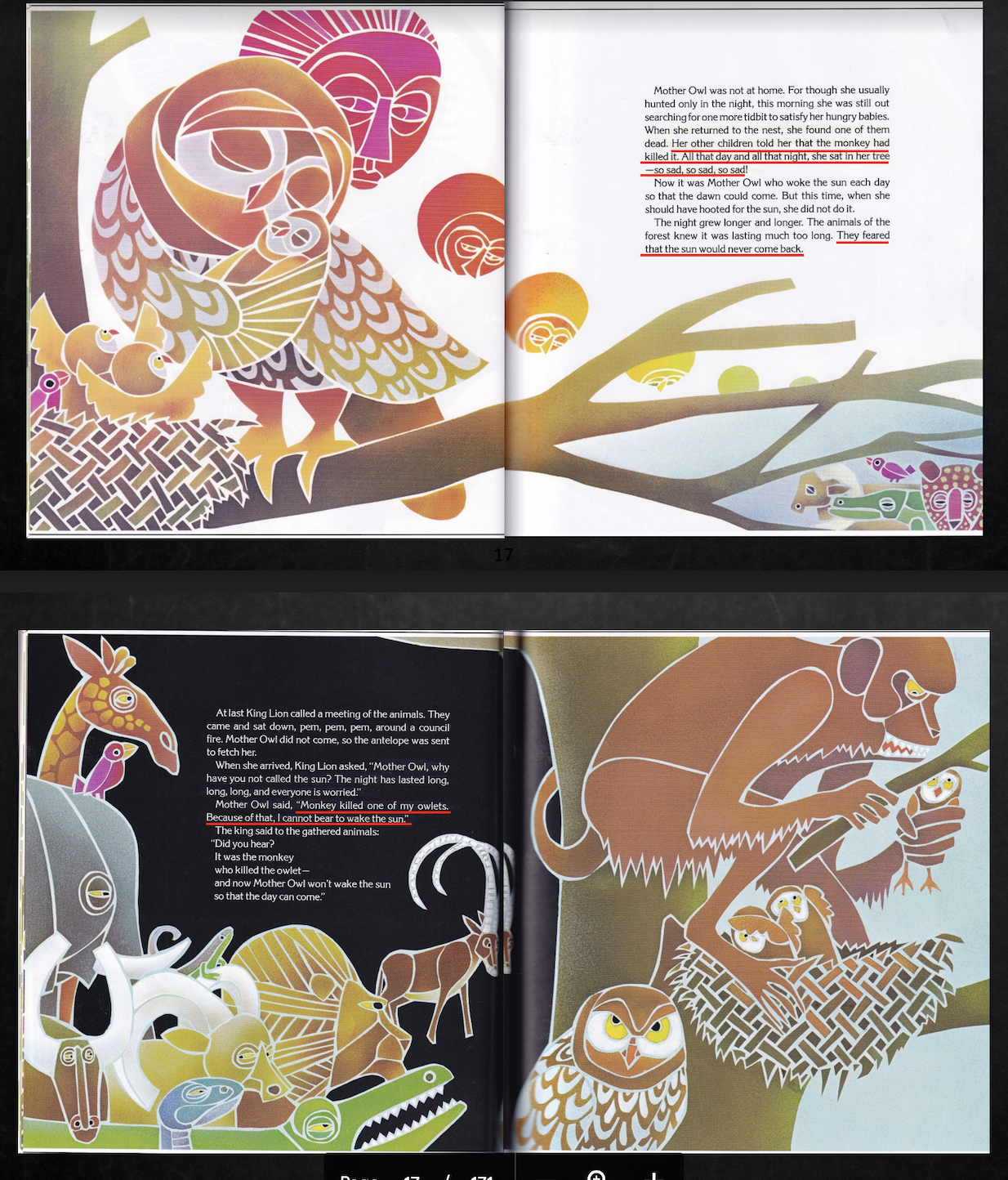
There is much more, including anti-Christian and anti-American sentiment and imagery, even an illustration of the reproductive life of seahorses to challenge the traditional family. Males carry the babies. The imagery is cute and sexual; the message is contemporary and affirms transgenderism. (You can find it all on the resource pages at the hotlink for “material.”)
Repetition within grades and up the grade levels towards fifth grade has a purpose. It is to introduce young students to a world without hope apart from societal strife in the name of social justice, a hallmark of Critical Race Theory, or “repackaged Marxism.”
Why do I say it is cunning?
Because it exploits the early childhood sense of living always in the immediate present. Children lack critical distance, such as adults have when they read fiction. They lack the ability to take whole views of a topic, including the curriculum they are passing through.
Children much older than those in kindergarten through fifth grade lack even the basics of an historical sense. According to the scholarship of Gerald Shlabach, a sense of history is a complex intellectual acquisition, a difficult attainment even for adults. Reading the entirety of Wit and Wisdom to gather its total impact is even more difficult, hence the tendency of some observers to deny its relationship with Marxism, nihilism, and Critical Race Theory, a postmodern phenomenon. That relationship isn't apparent on casual acquaintance.
The texts and images on race in "Wit and Wisdom" are taken largely from accounts of violence and discrimination against black and brown children during the Civil Rights Movement in the 1960’s.
When schoolchildren view these images, and throughout a nine week immersion in academic exercises about them, they are time-locked. Moreover, the teaching process, or pedagogy, is iterative, that is, designed for repetition that internalizes knowledge incrementally towards a predestined goal. The curriculum leaves children in the sixties when emotion about race and racism was at flood tide. Their imaginations and emotions are being shaped deliberately by a racist anachronism.
The use of the present tense in the illustrations from a book on Martin Luther King, Jr., points up the effort.
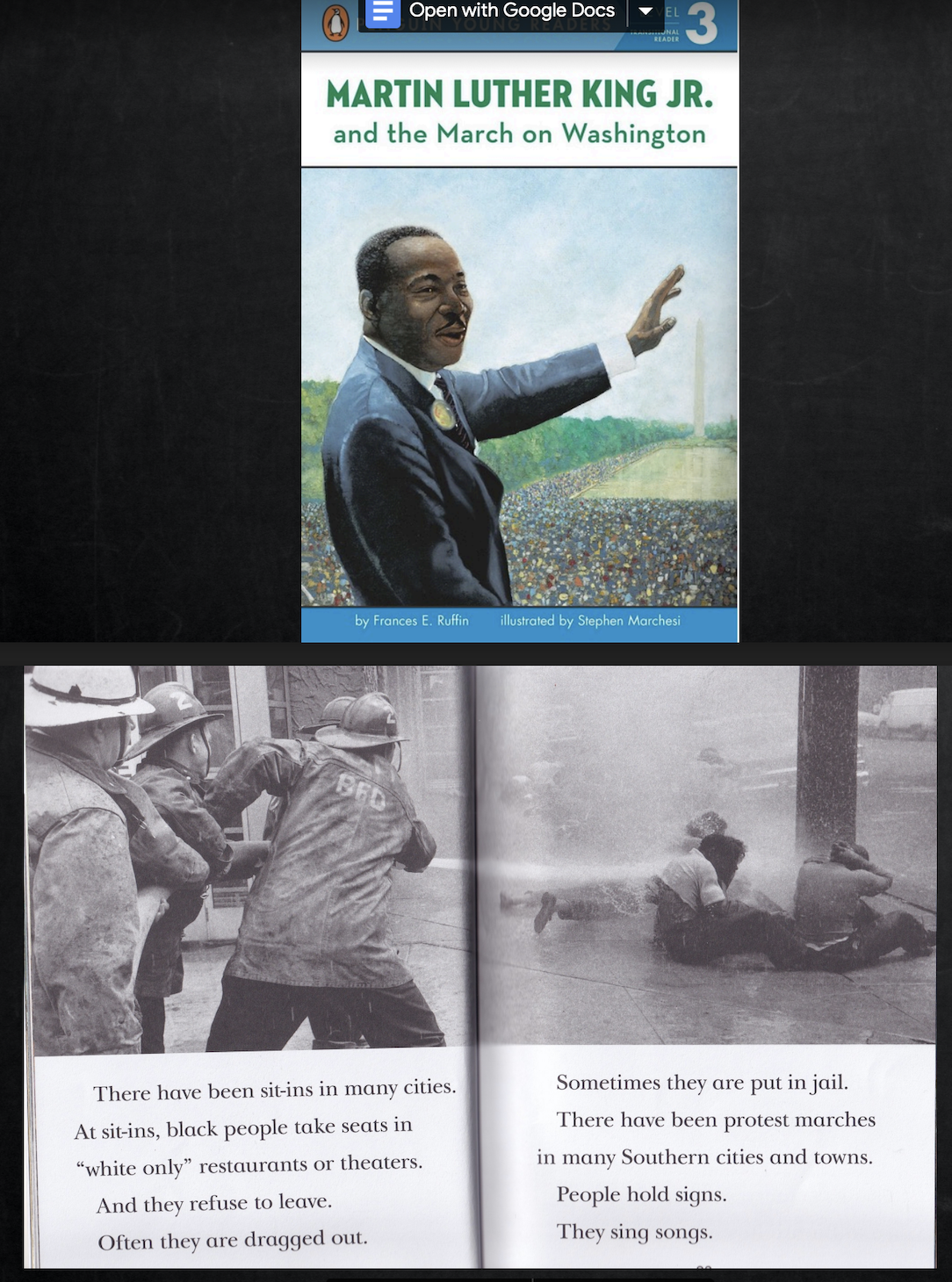
Teachers are directed in their manual to spend days on these images, adopting varying points of view on them and having children write their way into the pain of the people being hosed and into the hostility of the firemen. Here and elsewhere in the curriculum children are by design repeatedly conditioned to see their world, as Mrs. Steenman says, “as if nothing in race relations since the sixties has changed.”
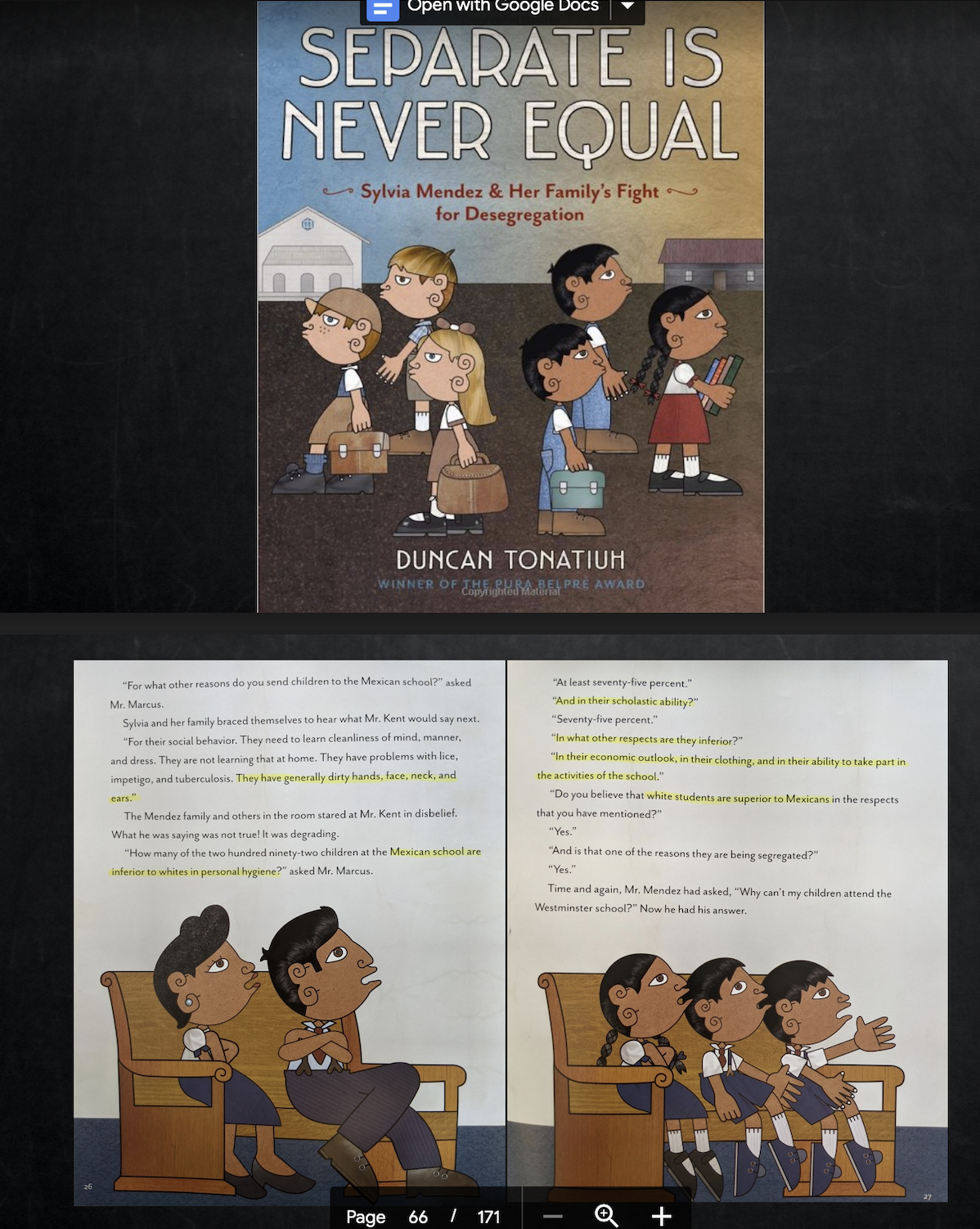
Of course, there is historical truth here. But nothing in this curriculum completes the picture to correct the impressions left on children's imaginations and emotions. And things have changed. Adults need only to look around to see that violence and racism are simply not omnipresent. But for children it is different. They are impressionable.
This curriculum is an example of intellectual dishonesty of a very sophisticated but low and debased kind.
Another word for it is evil: It exploits the emotional susceptibilities and affective extremes of children. Young children move from laughter to tears or from affection to anger upon slight provocation, often within seconds. “Wit and Wisdom” with little relief foregrounds sadness, hatred, fear, and shame.
Children living in their perpetual present are conditioned to fear or to be suspicious of one another—to feel fear, to be suspicious, to experience shame—because the recursive exercises include role-playing and point-of-view exercises in which the children for weeks at a time take the position of the abuser or abused, the oppressor or oppressed.
Writing exercises lead them to explain keywords, among others, “social justice” and “injustice,” “segregation” and “racism.” Prolonged repetition and powerful emotion reinforce memory, so the images and textbook accounts of racial persecution press deeply into the children, one surmises, with permanence. There are no supplemental truths, no counterpoints on love, caring, kindness, or gentleness, or faith. Cunning pedagogy, indeed.
Education can form; it can deform. The Wit and Wisdom curriculum is evil because it aims to deform the deep hearts of children who do not have the intellectual, critical, and emotional resources to counter it. Mrs. Steenman points out that this curriculum is in all fifty states. Her presentations point to the intentional misshaping of the minds and hearts of a generation of American students.
Mrs. Steenman told me that a bi-racial child developed and expressed hatred for his white half and thereby his white ancestry. His father documented this trauma in a letter to the School Board on March 23rd. At least one other child is in therapy. She is suicidal and believes that her grandparents should be killed for white transgressions in the remote past.
When Dan Cash, a Williamson County School Board member, held a town hall meeting, he brought a long list of books in the curriculum that he found issues with. Two hundred and fifty parents attended. When he finished his presentation, he turned the microphone over to parents. Mrs. Steenman says, "Parent after parent came to the microphone" with concerns about dark, age-inappropriate curricula and children troubled by the "dark" curricula.
A small child in therapy? White hatred, white shame so deep it turns children against themselves and their parents and grandparents? And yet white hatred and white shame, and black or brown inferiority, like white supremacy, are anachronisms and unrealities today unless they are formed in young children and adults by imagery and rhetoric that shape a deeply destructive race consciousness.
Does this amount to domestic terrorism against children? Against everyone?
In the late 1990s, according to James Lindsay and Helen Pluckrose, an abstruse academic discipline that swept university graduate programs took an activist turn and in easily grasped slogans took to the streets and the schools. Wit and Wisdom is one form of this activism. Their account of this turn appears in Cynical Theories: How Activist Scholarship Made Everything about Race, Gender, and Identity--and Why this Harms Everybody." This book will repay with dividends the time spent reading it.
Adult readers and reviewers of Wit and Wisdom not deeply acquainted with this curriculum or with critical theory most often find little to protest against, neither in the images nor the texts. But it takes more than adult casual reading. It takes prolonged reflection. It takes seeing with the "eyes" of a child’s heart. It takes being able to imagine childhood from the standpoint of a child’s suggestible mind. Minus that effort, adults can with much too much ease find the images cute and the texts valid history.
Many, in fact, have done so, and in very public places, such as opinion pieces in The New York Times. One is titled, “The South Must Teach Its Children the Truth” (August 2, 2021).
Indeed, yes! All of the truth in its completeness and complexity in view of age-readiness.
As Mrs. Steenman, who is not a Southerner, points out, children should be taught with age-appropriate material, with full historical contexts, with supplementary truths about progress in race relations and the good that pursuing the ideals of the founding documents of the United Staters has done.
Another writer who opposes Moms for Liberty observes that “Students Need to Learn about the Haters and the Helpers of Our History” (Washington Post, July 23, 2021). That writer lacked the opportunity to examine the curricula Moms for Liberty opposes. Balance is precisely what these mothers and dads advocate.
Schools should teach, for example, about the year-long conflict in New Orleans when Ruby Bridges was first to desegregate schools there if they broach the topic at all. But students should also know about the teacher who taught her gladly, the U. S. Marshall who protected her, and they should know about Ruby Bridges’ adult attitude towards her childhood persecutors. She came to advocate kindness among the races.
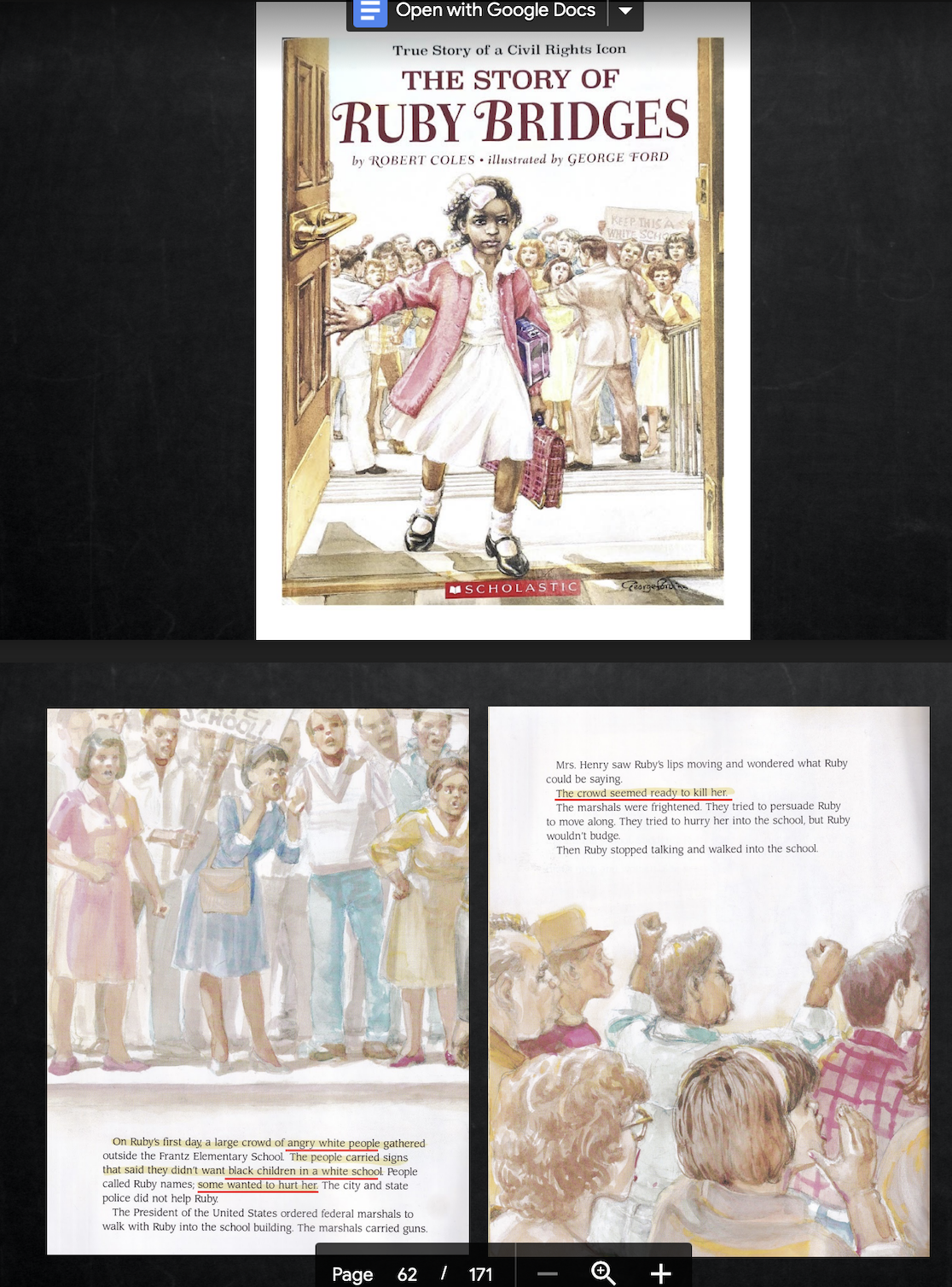
As Joe Carter points out in "9 Things You Should Know about Ruby Bridges and School Desegration":
"Ruby Bridges Hall is now chair of the Ruby Bridges Foundation, which she formed in 1999 to promote 'the values of tolerance, respect, and appreciation of all differences.' 'Each and every one of us is born with a clean heart,’ she says. 'Our babies know nothing about hate or racism. But soon they begin to learn—and only from us. We keep racism alive. We pass it on to our children. We owe it to our children to help them keep their clean start.'"
On such points, Wit and Wisdom is “Null,” as the Williamson County Moms put it.
The curriculum never passed review by the Tennessee Department of Education. It failed Tennessee standards for teaching English Language Arts a total of three times whereas other curricula passed on first review.
How was it authorized for use? In part, with grease-the-skids money funneled to Tennessee through the Bill Gates Foundation to SCORE, or State Collaborative on Reforming Education: at least $34 million, perhaps as much as $64 million.
In addition, the commissioner of the state DOE, Dr. Penny Schwinn, had cunningly piloted the program in seventeen counties, fired the first reviewers, allowed the pilot programs to continue, and then hired another group of reviewers. They, too, chose not to approve it, and they too were fired.
A third review occurred, closely observed by DOE. The curriculum failed again. Then the governor banned the use of curricula explicitly or implicitly teaching CRT. Dr. Schwinn responded by offering waivers to thirty-three counties to continue using of the materials.
As I understand this complicated and corrupt process, which the Moms for Liberty report describes in detail ("material," pp.141 through 165), the waivers remain in force until the end of 2022. But in the meantime, Dr. Schwinn has been stripped of waiver authority.

The struggle continues in all 50 states, and the federal government has now become overtly involved with the full force of the Justice Department, the White House, and the FBI.
This is a national absurdity, laughable if it were not dangerous, an unconstitutional breach of constitutional freedoms, and another instance of the federal government breaking its own legal boundaries.
There needs to be a strong check on this illegal federal overreach in matters that belong solely to localities.
Convention of States can provide remedies: amendments to the Constitution that restrict federal jurisdiction and power, that discourage corruption by posing limits to the number of terms elected and unelected officials may serve, and by cutting the federal government’s ability to fund such actions as those now aimed at innocent parents absurdly accused of domestic terrorism.
At this moment 19 states have advanced a resolution to hold such a convention – 34 are needed.
Join us to stop the abuses and absurdity.


